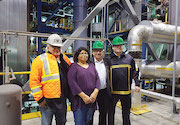| |
| |
 |
 |
| |
 |
|
@{mv_date_MMM d, yyyy}@ |
|
| |
 Thanks to a $50,000 grant from WorkSafeBC, Dalhousie University and its project partners,
the Wood Pellet Association of Canada, BC Forest Safety Council and DustEx Research Ltd., are launching a research project to look at integrating process safety management (PSM) into pellet plants that generate combustible wood dust.
» Read more...
Thanks to a $50,000 grant from WorkSafeBC, Dalhousie University and its project partners,
the Wood Pellet Association of Canada, BC Forest Safety Council and DustEx Research Ltd., are launching a research project to look at integrating process safety management (PSM) into pellet plants that generate combustible wood dust.
» Read more...
The city chose not to move forward with the project because it is financially too risky, despite the fact that much of the funds would have come from grants.
» Read more...
Recently, the Nazko First Nation hosted its 4th Annual Tree Planting Celebration. PacBio, a Wood Pellet Association of Canada (WPAC) member, contributed 400 seedlings for Nazko members and partners. Check out the video about the partnership!
» Read more...
“With the plant, it will be possible to provide 8,300 additional homes with bio district heat and 7,000 additional homes with ecologically produced power in Salzburg in the future,” says Siegfried Müllegger, head of energy technologies, Salzburg AG.
» Read more...
New features of the Super Screener include longer machine life thanks to a 15 per cent lighter basket and increased durability with oversize hangers.
» Read more...
|
| |
 |
 |
| |
|
| |
 Across Canada, the forest industry is facing a problem: what to do with the low-grade fibre left in the forests after harvesting. Cogeneration plants like Hornepayne Power, based in Hornepayne, Ont., offer one solution: using residual fibre to produce electricity and steam.
» Read more...
Across Canada, the forest industry is facing a problem: what to do with the low-grade fibre left in the forests after harvesting. Cogeneration plants like Hornepayne Power, based in Hornepayne, Ont., offer one solution: using residual fibre to produce electricity and steam.
» Read more... |
| |
 In this recent episode of The Construction Record podcast, UBC professor Gary Bull discusses the innovative uses for wood pellets as an energy source in Europe as well as advancements in B.C. and the potential to supply global customers with a sustainable, environmentally friendly fuel source to displace coal-fired electricity.
» Read more...
In this recent episode of The Construction Record podcast, UBC professor Gary Bull discusses the innovative uses for wood pellets as an energy source in Europe as well as advancements in B.C. and the potential to supply global customers with a sustainable, environmentally friendly fuel source to displace coal-fired electricity.
» Read more... |
| |
|
| |
|
|
| |
| |







